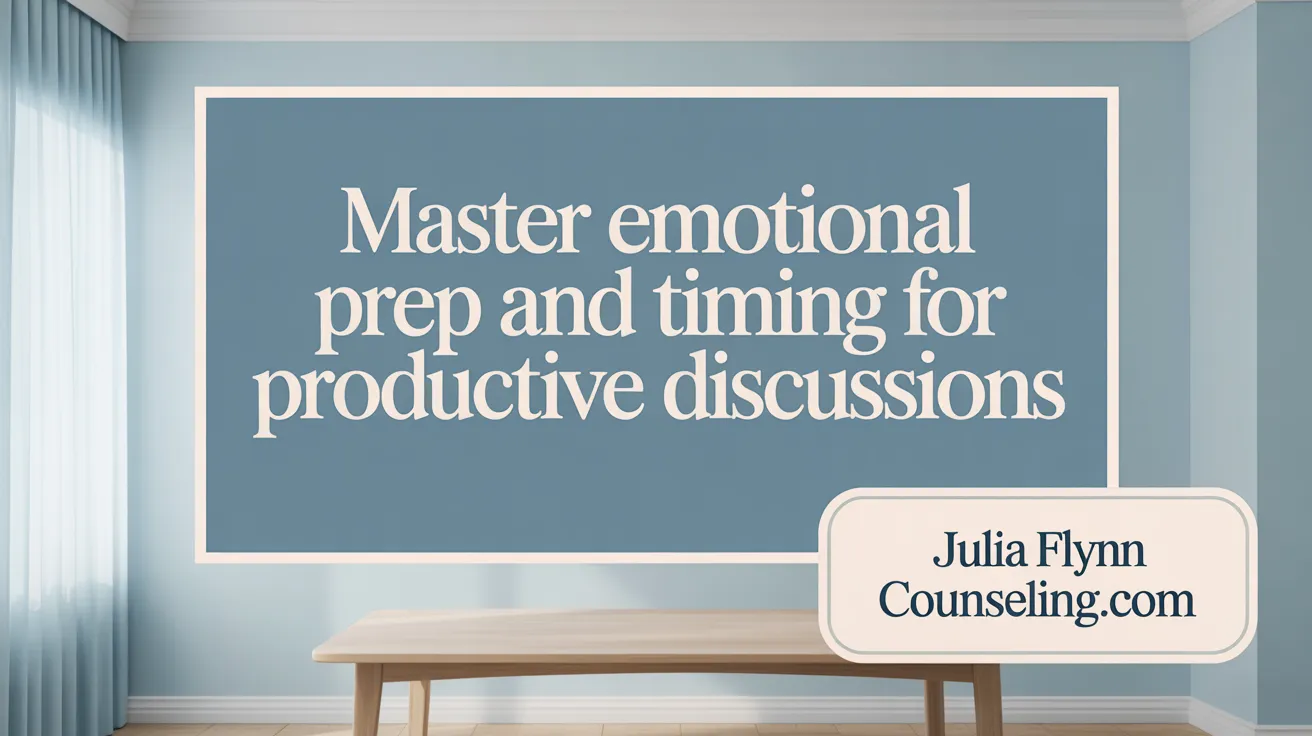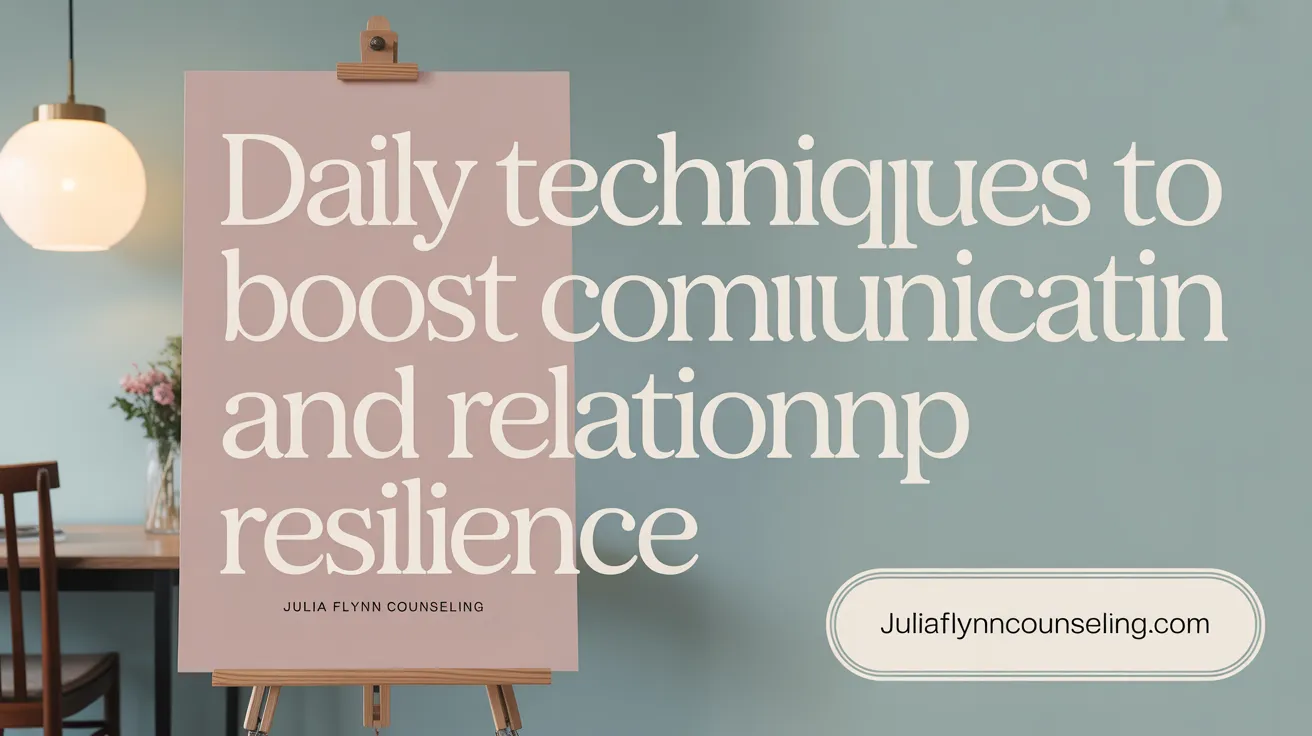Why Effective Communication is the Cornerstone of Healthy Relationships
Communication is the foundation of strong, healthy relationships.
It allows partners to share feelings, needs, and experiences clearly and respectfully. Without effective communication, misunderstandings and resentment can easily grow.
Impact on trust and emotional connection
When couples communicate openly and honestly, trust deepens. Expressing vulnerabilities and listening with empathy builds a safe emotional space. This connection fosters closeness, reduces conflict, and promotes long-term satisfaction.
Common communication challenges
Poor communication patterns include avoidance, passive-aggression, and aggressive speech. Other pitfalls like silent treatment, bringing up past mistakes, and disrespectful body language harm relationships. Timing conversations thoughtfully and processing emotions before discussing issues help prevent conflicts.
Using "I" statements and active listening
Starting discussions with "I" statements helps express feelings without blame. Active listening—fully focusing on understanding a partner's perspective—strengthens empathy and resolution.
By understanding and addressing these challenges, partners can build trust, deepen emotional bonds, and foster a fulfilling relationship through effective communication.
Recognizing and Overcoming Communication Barriers
What Are Signs of Poor Communication?
Poor communication in relationships often manifests through behaviors such as passive-aggressive behavior, avoidance of conflict, and managing aggressive speech. These patterns can create tension and distance between partners, hindering effective communication in relationships and healthy communication. Recognizing these signs early is essential for addressing underlying problems before they escalate.
What Communication Pitfalls Should Partners Avoid?
Avoiding common pitfalls like the silent treatment effects, bringing up past mistakes during current conflicts, avoiding yelling in communication, negative impact of sarcasm, disrespectful body language, and walking away mid-conversation is crucial. These habits disrupt healthy communication habits and can damage trust and emotional intimacy.
How Do Passive-Aggressive, Aggressive Speech, and Avoidance Impact Relationships?
Passive-aggressive communication promotes resentment and confusion, aggressive speech can create fear or withdrawal, while avoidance leads to unresolved issues piling up. All three contribute to misunderstandings and erode the emotional connection and trust that are foundational to any relationship.
How Can Partners Address Misunderstandings?
Partners can improve understanding by processing feelings before conversation, choosing best timing for serious talks, and using “'I' statements in communication” to express emotions without assigning blame. Active listening techniques and focus on understanding partner rather than winning an argument foster empathy and clearer communication.
By identifying and actively working to overcome these barriers, couples can cultivate healthier conversations and stronger bonds.
Emotional Processing and Timing: Preparing for Constructive Conversations

Processing Emotions Before Discussion
Before entering any serious conversation with your partner, it's important to process your feelings privately. Taking time to understand and calm your emotions can prevent the discussion from becoming heated or unproductive. This preparation helps you communicate more clearly and respond thoughtfully instead of reacting impulsively. See more on processing feelings before conversation.
Choosing Appropriate Timing and Setting
Selecting the right moment and environment for important talks is key. Avoid bringing up sensitive issues when either partner feels rushed, tired, or stressed. Find a quiet, comfortable space free of distractions where both can focus on the discussion. For more on best timing for serious talks and avoiding communication pitfalls.
Heads-Up Before Serious Talks
Giving your partner advance notice that you want to discuss something meaningful helps reduce anxiety and resistance. This heads-up signals that the upcoming conversation is important, allowing time for mental and emotional preparation. Learn about leaving notes for communication and regular relationship check-ins for helpful techniques.
Managing Emotional Control
Staying emotionally regulated during conversations allows both partners to share openly and listen actively. Techniques such as deep breathing or taking a brief pause when emotions escalate can keep discussions constructive and respectful. Explore emotional regulation techniques and active listening techniques in therapy for guidance.
By prioritizing emotional processing, timing, and setting, couples foster a healthier communication climate that encourages mutual understanding and stronger connection. For more, see effective communication in relationships.
Using 'I' Statements and Assertive Communication to Foster Understanding

What Are 'I' Statements in Communication and How Are They Used?
'I' statements are expressions where a person focuses on their own feelings and experiences rather than assigning blame. For example, saying, "I feel upset when plans change last minute," communicates emotions clearly without accusing the other person. This method helps open constructive dialogue and promotes empathy.
What Is the Difference Between Passive, Aggressive, and Assertive Communication?
Communication styles shape how messages are delivered and received:
- Passive communication avoids expressing feelings or needs, often leading to misunderstandings or resentment.
- Aggressive communication involves expressing feelings in a hostile or blaming manner, which can escalate conflicts.
- Assertive communication balances honesty with respect, clearly expressing feelings and needs without aggression or passivity.
Assertiveness is widely recognized as the healthiest style for fostering understanding in relationships.
How Do 'I' Statements in Communication and Assertive Communication Reduce Blame and Defensiveness?
By focusing on one's own feelings rather than blaming others, 'I' statements reduce the chance the listener feels attacked. Assertive communication maintains respect for both parties, which lowers defensiveness. This approach encourages partners to listen openly and respond empathetically rather than reacting emotionally.
How Can One Express Feelings Clearly Using These Techniques?
Start conversations with statements like "I feel... when... because..." to convey emotions and reasons clearly. Combine this with Active listening techniques to validate your partner's perspective. Being direct yet respectful helps ensure your needs and feelings are understood without hostility.
Adopting 'I' statements and assertive communication nurtures openness and strengthens emotional connection by promoting honest and compassionate exchanges.
Active Listening and Nonverbal Communication: Deepening Empathy and Connection

Components of Active Listening
Active listening is a foundational communication skill that involves fully focusing on your partner’s words, tone, and emotions. It requires giving undivided attention through eye contact, open body posture, and nodding to show engagement. Avoiding interruptions and refraining from formulating responses while your partner is speaking ensures that their message is heard in its entirety.
Reflection and Paraphrasing Techniques
A powerful way to show understanding is by reflecting or paraphrasing what your partner has said. This involves restating their thoughts or feelings in your own words, such as, "It sounds like you're feeling overwhelmed when..." This method validates their experience and encourages deeper sharing without judgment. Learn more about reflection techniques and healthy communication and active listening techniques.
Role of Body Language, Tone, and Facial Expressions
Nonverbal communication conveys much of the emotional context in conversations. Positive body language—like nodding and leaning slightly forward—signals attentiveness. Facial expressions and tone of voice help interpret feelings behind words; for example, a gentle tone paired with soft eye contact can communicate empathy and safety. Understanding nonverbal communication skills is crucial for effective communication.
Avoiding Interruptions and Distractions
Effective communication flourishes when distractions are minimized. This means putting away phones, maintaining eye contact, and resisting the urge to interrupt. Such practices allow your partner to feel truly heard and respected, fostering stronger emotional connection and trust. Explore tips on avoiding communication pitfalls and strategies for effective communication in relationships.
Incorporating these active listening practices and paying attention to nonverbal cues greatly enhance empathy and understanding in relationships, leading to healthier and more fulfilling connections. For more strategies, see effective communication in relationships.
Conflict Resolution: Moving Beyond Arguments Toward Compromise and Understanding

How can couples focus on resolution rather than winning?
Focusing on resolution means prioritizing understanding and compromise instead of trying to "win" the argument. This approach fosters trust, emotional connection, and long-term harmony in relationships. Couples are encouraged to express feelings using "I" statements in communication, avoid blame, and listen deeply to each other’s perspectives. The goal is to collaboratively solve the problem rather than score points.
What are some constructive conflict techniques?
Effective techniques include Active listening techniques, using empathetic language, and staying on the present issue rather than dredging up past mistakes. Practicing patience and avoiding hostile behaviors such as yelling or sarcasm helps keep the dialogue respectful and productive. Assertive communication allows partners to voice needs honestly while respecting the other's feelings.
How do time-outs help during conflicts?
Taking a time-out when emotions escalate prevents further hurt and de-escalates tension. This break allows partners to process feelings, calm down, and return to the conversation with greater clarity and openness. Time-outs should be agreed upon mutually and used as a tool to foster healthy discussions rather than avoidance. For guidance on Healthy conflict resolution strategies, including use of time-outs, see relevant resources.
Why is acknowledging and owning one's role important?
Recognizing one’s contribution to a conflict encourages accountability and reduces defensiveness. When partners own their part and express empathy, it opens the door to mutual understanding and healing, creating a safer space for honest dialogue. Learn more about the importance of accountability and empathy in communication.
How can couples find win-win solutions?
Couples can strive for outcomes that respect both partners' needs and priorities through compromise and collaboration. Engaging in Solution-focused dialogue, exploring creative options, and maintaining a spirit of teamwork turns conflicts into opportunities for growth and deeper connection. For strategies on Constructive conflict resolution strategies and collaborative communication, see helpful exercises and approaches.
Setting Boundaries: Respecting Space, Emotions, and Digital Presence
Why Are Physical, Emotional, and Digital Boundaries Important?
Boundaries in relationships serve as essential guidelines to respect personal space, feelings, and privacy. They protect individuals from emotional overwhelm and misunderstandings, fostering healthier and more trusting connections. Physical boundaries help partners honor each other's need for personal space. Emotional boundaries prevent one partner's feelings from overwhelming the other, maintaining balance and empathy. Digital boundaries safeguard privacy in the increasingly interconnected world, reducing conflicts over online interactions. For more on the importance of setting clear communication boundaries and importance of emotional safety, see resources on healthy communication, communication and mental health, and effective communication in relationships.
How Can Boundaries Be Clearly Communicated?
Clear communication is vital for setting effective boundaries. This involves expressing your needs openly and respectfully, using "I" statements in communication—for example, saying, "I feel uncomfortable when my messages are read without a response," promotes understanding. Ensuring discussions about boundaries occur in calm moments, rather than during conflict, enhances receptivity. Regular relationship check-ins support ongoing adjustment and reinforce respect. Effective communication techniques such as active listening techniques and processing feelings before conversation are also essential for this process.
How Do Boundaries Prevent Miscommunication and Resentment?
Boundaries create a framework that helps prevent unspoken expectations, reducing assumptions that often lead to frustration. By clearly defining limits, partners avoid crossing emotional or physical lines that can damage trust. This transparency decreases passive-aggressive behavior, builds mutual respect, and supports emotional safety. Understanding and avoiding communication pitfalls such as avoiding conflict avoidance and managing aggressive speech are key to fostering healthy interaction. Utilizing constructive conflict resolution strategies helps partners maintain respect and empathy.
What Are Examples of Setting Boundaries?
- Physical: Agreeing on time alone after work to decompress before discussing sensitive topics.
- Emotional: Processing feelings before conversation by communicating when needing space to process feelings before sharing.
- Digital: Establishing rules about sharing passwords, responding to texts, or social media interactions.
Respecting these boundaries nurtures relationship satisfaction and emotional well-being for both partners. For more examples and exercises on boundary setting and communication, see resources on effective communication in relationships and communication exercises for couples therapy.
Sustaining Connection Through Regular Check-Ins and Positive Practices
Why Are Regular Communication Check-Ins Important?
Regular communication check-ins serve as vital touchpoints that help couples maintain emotional connection and ensure both partners feel heard and valued. These brief, consistent conversations can de-escalate potential misunderstandings before they grow into conflicts. Scheduled check-ins create a space to express needs, share feelings, and address concerns openly, fostering ongoing trust and emotional safety within the relationship.
How Do Leaving Notes and Expressing Gratitude Help?
Small gestures like leaving thoughtful notes and expressing gratitude regularly contribute significantly to relationship satisfaction. These acts of kindness not only brighten a partner’s day but also reinforce feelings of appreciation and recognition. Showing gratitude helps build a positive atmosphere where partners feel valued and encouraged to continue sharing with one another.
What Is the Role of Dedicated Conversation Times?
Setting aside dedicated times for meaningful conversations—such as weekly sessions or “check-in” moments—helps couples stay connected amid busy lives. This intentional scheduling prioritizes the relationship, allowing partners to focus fully without distractions. Dedicated times encourage deeper dialogue about both joyful experiences and challenges, promoting mutual understanding.
How Does Appreciation Build Trust?
Expressing appreciation cultivates trust by demonstrating recognition of each other’s efforts and qualities. Regular verbal acknowledgement nurtures emotional intimacy, making it easier for partners to be open, vulnerable, and supportive. This foundation of trust empowers couples to navigate conflicts constructively and strengthens their emotional bond over time.
When to Seek Professional Support: Therapy as a Communication Tool
Benefits of Couples and Individual Therapy
Therapy offers a safe, structured environment for individuals and couples to improve communication skills and resolve relational challenges. Couples therapy helps partners identify unhealthy communication patterns, express their feelings constructively, and work toward mutual understanding. Individual therapy supports self-awareness, emotional regulation techniques, and personal growth, which indirectly improves relationship interactions.
Therapeutic Communication Techniques
Professional therapists employ techniques such as Active listening techniques in therapy, empathy, validation, and the use of open-ended questions. These approaches encourage clients to share openly without fear of judgment. Therapists also teach clients to use ‘I’ statements in communication], helping reduce blame and promote authentic emotional expression. Nonverbal cues, tone modulation, and reflective listening are emphasized to deepen understanding.
Repairing Relational Ruptures
Misunderstandings or disagreements can create ruptures in relationships. Therapy facilitates the repair of these breaks by clarifying misunderstandings, validating emotions, and exploring underlying issues. Therapists guide couples to revisit difficult conversations constructively, helping rebuild trust and strengthen their connection over time.
Building Strong Communication Skills with Professional Help
Regular therapy sessions allow individuals and couples to practice and refine communication techniques, set healthy boundaries, and develop problem-solving strategies. Therapists provide personalized feedback and tools, such as the Speaker-Listener technique and conflict de-escalation methods, empowering clients to sustain healthier interactions beyond therapy.
Seeking professional support is a proactive step toward nurturing resilient, respectful, and emotionally connected relationships through enhanced communication.
Practical Communication Exercises and Techniques for Daily Relationship Growth

Communication exercises like validation and mirroring
Regular communication exercises help partners deepen trust and emotional connection. Validation exercises focus on acknowledging and affirming each other's feelings, fostering a sense of security and acceptance. Mirroring exercises encourage partners to repeat back or paraphrase what the other has shared, promoting understanding and ensuring both feel heard.
Using the LARA and DEAR MAN methods
Structured communication techniques provide practical tools for expressing needs and resolving conflicts. The LARA method—Listen, Affirm, Respond, Add emphasizes active listening and empathetic responses to enhance mutual understanding. The DEAR MAN skill from Dialectical Behavior Therapy helps set boundaries and make requests assertively by describing the situation, expressing feelings, asserting needs, reinforcing benefits, maintaining mindfulness, appearing confident, and negotiating.
Active engagement through positive language
Employing positive language fosters healthy dialogue and emotional safety. Practicing gratitude and expressing happy feelings regularly create a foundation of trust and openness. Using 'I' statements helps convey emotions without blame, reducing defensiveness and encouraging empathy.
Role-playing and open-ended questions
Role-playing allows couples to practice communication skills in safe, supportive scenarios, preparing them for real-life conversations. Open-ended questions invite deeper sharing and understanding by encouraging detailed responses and genuine dialogue.
Incorporating these exercises consistently aids couples in managing emotions, preventing misunderstandings, and building stronger bonds through clearer and more compassionate communication.
Building Lasting Bonds: The Journey to Stronger Relationships Through Communication
Essential Communication Strategies for Healthy Relationships
Maintaining strong relationships relies heavily on effective communication. Key approaches include using 'I' statements to express feelings without blame, engaging in active listening where each partner feels heard, and practicing emotional validation to foster empathy and understanding. Timing discussions thoughtfully and setting clear boundaries—physical, emotional, and digital—help prevent misunderstandings.
The Role of Practice and Empathy
Consistent practice is vital; regular check-ins and dedicated conversations enable couples to navigate challenges constructively. Empathy enhances communication by allowing partners to appreciate each other's perspectives, reducing defensiveness and encouraging mutual support. Managing emotions before conversations helps maintain respect and openness.
Nurturing Open and Honest Dialogue
Encouragement of honest and respectful sharing creates a safe space for vulnerability, deepening trust and emotional intimacy. Open-ended questions and avoiding common pitfalls—such as silence, sarcasm, or bringing up past conflicts—support healthier interaction. Over time, cultivating this open dialogue builds resilience and strengthens bonds, laying the groundwork for long-lasting connections.
